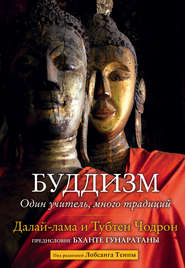По всем вопросам обращайтесь на: info@litportal.ru
(©) 2003-2024.
✖
The Dalai Lama’s Book of Transformation
Автор
Год написания книги
2018
Настройки чтения
Размер шрифта
Высота строк
Поля
In May 1999 His Holiness the Dalai Lama gave three days’ teachings on The Eight Verses on Transforming the Mind at the Wembley Conference Centre in London. His Holiness’ visit to the United Kingdom took place at the request of the Tibet House Trust, UK.
The Eight Verses on Transforming the Mind is one of the most important texts from a genre of Tibetan spiritual writings known as the lo-jong, literally ‘transforming the mind.’ Written by the eleventh-century Tibetan master Langri Thangpa, this short work is referred to by His Holiness as one of his main sources of inspiration.
Central themes of the lo-jong teachings include, amongst others, the enhancement of compassion, the cultivation of balanced attitudes towards self and others, the development of positive ways of thinking, and the transformation of adverse situations into conditions favorable to spiritual development.
The Office of Tibet would like to thank Jane Rasch and Cait Collins for transcribing the teachings and Dominique Side for editing. We are grateful to Dr Thupten Jinpa for interpreting His Holiness’ teachings into English and also for helping with the editing of the final manuscript.
Mr Migyur Dorjee
Representative of His Holiness the Dalai Lama
in London
PART ONE (#ulink_b736c82c-58c0-5dbb-9815-06f5b85ab6f6)
THE BASIS OF TRANSFORMATION (#ulink_b736c82c-58c0-5dbb-9815-06f5b85ab6f6)
The whole point of transforming our heart and mind is to find happiness. We all have the natural desire to be happy and the wish to overcome suffering. This is a fact, so we can make it our starting-point.
Before developing this point in more detail, however, let us look very briefly at the nature of experience. Broadly speaking, our experiences fall into two categories. One type of experience is more connected with our bodies, and occurs mainly through our sense organs, while the other type is more related to what can be called ‘the mental consciousness’ or ‘the mind.’
So far as the physical level of experience is concerned, there is not much difference between ourselves and other animal species. Animals, too, have the capacity to feel both pain and well-being. But what perhaps distinguishes us human beings from other forms of life is that we have far more powerful mental experiences in the form of thoughts and emotions.
The fact that there are two broad categories of experience has some interesting implications. Most importantly, if a person’s basic state of mind is serene and calm, then it is possible for this inner peace to overwhelm a painful physical experience. On the other hand, if someone is suffering from depression, anxiety, or any form of emotional distress, then even if he or she happens to be enjoying physical comforts, he will not really be able to experience the happiness that these could bring. So this shows that our state of mind, in terms of our attitudes and emotions, plays a crucial role in shaping the way we experience happiness and suffering. The lo-jongteachings on transforming the mind offer a series of methods by which we can channel and discipline our mind, and so create the basis for the happiness we are seeking.
We all know that there is an intimate connection between physical well-being and emotional well-being. We know, for example, that physical illnesses affect our state of mind, and that, conversely, a greater degree of physical well-being contributes towards greater mental ease. Since we commonly recognize this correlation, many of us engage in physical practices and exercises to help bring about that physical well-being which will contribute to our mental refreshment. There are also certain traditional practices that are aimed at training our energy patterns; these are called prana yogas, or ‘yogas of the wind energy.’ These days, yogic exercises have become very popular in the modern world, too, and this is precisely because many people have found that through yoga they can achieve a degree of physical health that leads to better mental health. The approach that is suggested by the lo-jongteachings is slightly different, however. They concentrate directly on the development of the mind itself, through the transformation of our attitudes and ways of thinking.
The key to transforming our hearts and minds is to have an understanding of the way our thoughts and emotions work. We need to learn how to identify the opposing sides in our inner conflicts. With anger, for example, we need to see how destructive anger is, and, at the same time, realize that there are antidotes within our own thoughts and emotions that we can use to counter it. So, first, by understanding that afflictive thoughts and emotions are destructive and negative, and, second, by trying to strengthen our positive thoughts and emotions, which are their antidotes, we can gradually reduce the force of our anger, hatred and so on.
The way to examine how thoughts and emotions arise in us is through introspection. It is quite natural for many different thoughts and emotions to arise. When we leave them unexamined and untamed this leads to untold problems, crises, suffering and misery. This is why we need to adopt the conscious discipline we spoke of earlier: in order to reduce the power of a negative emotion like anger or hatred, we need to encourage its antidote, which is love and compassion.
It is not enough to recognize that this is what is required, just as it is not enough simply to wish that love and compassion should increase in us. We have to make a sustained effort, again and again, to cultivate the positive aspects within us, and the key here is constant familiarity. The nature of human thoughts and emotions is such that the more you engage in them, and the more you develop them, the more powerful they become. Therefore we have to develop love and compassion consciously in order to enhance their strength. We are, in fact, talking about a way of cultivating habits that are positive. We do this through meditation.
MEDITATION: A SPIRITUAL DISCIPLINE (#ulink_776c47ac-1bba-5c03-8931-84ca321754b0)
What do we understand by meditation? From the Buddhist point of view, meditation is a spiritual discipline, and one that allows you to have some degree of control over your thoughts and emotions.
Why is it that we don’t succeed in enjoying the lasting happiness that we are seeking? Buddhism explains that our normal state of mind is such that our thoughts and emotions are wild and unruly, and since we lack the mental discipline needed to tame them, we are powerless to control them. As a result, they control us. And thoughts and emotions, in their turn, tend to be controlled by our negative impulses rather than our positive ones. We need to reverse this cycle.
The idea of bringing about such a fundamental change in ourselves may at first sight seem impossible, yet it is actually possible to do this through a process of discipline such as meditation. We choose a particular object, and then we train our minds by developing our ability to remain focused on the object. Normally, if we just take a moment to reflect, we will see that our mind is not focused at all. We may be thinking about something and, all of a sudden, we find that we have been distracted because something else came into our head. Our thoughts are constantly chasing after this and that because we don’t have the discipline of having a focus. So, through meditation, what we can achieve is the ability to place our minds and to focus our attention at will on any given object.
Now of course, we could choose to focus on a negative object in our meditation. If, for example, you are infatuated with someone, and if you focus your mind single-pointedly on that person, and then dwell on their desirable qualities, this will have the effect of increasing your sexual desire for that person. But this is not what meditation is for. From a Buddhist point of view, meditation has to be practiced in relation to a positive object, by which we mean an object that will enhance your ability to focus. Through that familiarity you become closer and closer to the object and feel a sense of intimacy with it. In the classical Buddhist literature this type of meditation is described as shamatha, tranquil abiding, which is a single-pointed meditation.
Shamatha alone is not sufficient. In Buddhism, we combine single-pointed meditation with the practice of analytic meditation, which is known as vipasyana, penetrative insight. In this practice we apply reasoning. By recognizing the strengths and weaknesses of different types of emotions and thoughts, together with their advantages and disadvantages, we are able to enhance our positive states of mind which contribute towards a sense of serenity, tranquility, and contentment, and to reduce those attitudes and emotions that lead to suffering and dissatisfaction. Reasoning thus plays a helpful part in this process.
Whatever forms of meditation you practice, the most important point is to apply mindfulness continuously, and make a sustained effort. It is unrealistic to expect results from meditation within a short period of time. What is required is continuous sustained effort.
PART TWO (#ulink_2c88d2cf-84a7-5d58-96d3-f2261b3e56ea)
THE QUALITIES OF BODHICHITTA, THE ALTRUISTIC INTENTION (#ulink_090f7e38-c7c5-579c-a8b2-b6148376f27c)
The definition of bodhichitta is given in Maitreya’s Ornament of Realization, where he states that there are two aspects to altruism. The first is the condition that produces the altruistic outlook, and this involves the compassion that a person must develop towards all sentient beings, and the aspiration he or she must cultivate to bring about the welfare of all sentient beings. This leads to the second aspect, which is the wish to attain enlightenment. It is for the sake of benefitting all beings that this wish should arise in us.
We could say that bodhichitta is the highest level of altruism and the highest form of courage, and we could also say that bodhichitta is the outcome of the highest altruistic activity. As Lama Tsongkhapa explains in his Great Exposition of the Path to Enlightenment,bodhichitta is such that while one engages in fulfilling the wishes of others, the fulfillment of one’s own self-interest comes as a by-product. This is a wise way of benefitting both oneself and others. In fact I think bodhichitta is really and truly wonderful. The more I think of helping others, and the stronger my feeling for taking care of others becomes, the more benefit I reap myself. That is quite extraordinary.
In a sense we could say that the practice of generating and cultivating the altruistic intention is so comprehensive that it contains the essential elements of all other spiritual practices. Taken alone, it can therefore replace the practice of many different techniques, since all other methods are distilled into one approach. This is why we consider that bodhichitta practice lies at the root of both temporary and lasting happiness. Now the question is how we can train ourselves to develop bodhichitta. The two aspects of bodhichitta that we spoke about earlier, the aspiration to be of help to others and the aspiration to attain enlightenment oneself, have to be cultivated separately through separate trainings. The aspiration to be of help to others has to be cultivated first.
THE TWO ALTRUISTIC ASPIRATIONS (#ulink_87619af9-1b1d-58c4-8b66-ee49e923bded)
1. The aspiration to attain enlightenment
The highest form of spiritual practice is the cultivation of the altruistic intention to attain enlightenment for the benefit of all sentient beings, known as bodhichitta. This is the most precious state of mind, the supreme source of benefit and goodness, that which fulfills both our immediate and ultimate aspirations, and the basis of altruistic activity. However, bodhichitta can only be realized through regular concerted effort, so in order to attain it we need to cultivate the discipline necessary for training and transforming our mind.
As we discussed earlier, the transformation of mind and heart does not happen overnight but through a gradual process. Although it is true that in some cases instantaneous spiritual experiences may be possible, they are rather unreliable and somewhat shortlived. The problem is that when sudden experiences occur, like bolts of lightning, the individual may feel profoundly moved and inspired, but if the experiences are not grounded in discipline and sustained effort they are very unpredictable, and their transformative impact will be rather limited. By contrast, a genuine transformation that results from sustained concerted effort is long-lasting because it has a firm foundation. This is why long-term spiritual transformation can really only come about through a gradual process of training and discipline.
The potential for perfection, the potential for full enlightenment, actually lies within each one of us. In fact this potential is nothing other than the essential nature of the mind itself, which is said to be the mere nature of luminosity and knowing. Through the gradual process of spiritual practice, we can eliminate the obstructions that hinder us from perfecting this seed of enlightenment. As we overcome them, step by step, so the inherent quality of our consciousness begins to become more and more manifest until it reaches the highest stage of perfection, which is none other than the enlightened mind of the Buddha.
2. Working for the welfare of others
The other aspiration of the altruistic intention (bodhichitta) is the wish to bring about the welfare of other sentient beings. Welfare, in the Buddhist sense, means helping others to attain total freedom from suffering, and the term ‘other sentient beings’ refers to the infinite number of beings in the universe. This aspiration is really the key to the first, namely the intention to attain enlightenment for the benefit of all sentient beings. It is founded on genuine compassion towards all sentient beings equally. Compassion here means the wish that all other beings should be free of suffering. So it is said to be at the root of all altruistic activity and of the altruistic intention as a whole.
We need to cultivate a compassion that is powerful enough to make us feel committed to bringing about the well-being of others, so that we are actually willing to shoulder the responsibility for making this happen. In Buddhism, such compassion is called ‘great compassion.’ The point is emphasized again and again that great compassion is the foundation of all positive qualities, the root of the entire Mahayana path, and the heart of bodhichitta. Likewise, Chandrakirti says in his Entry to the Middle Way that compassion is such a supreme spiritual quality that it maintains its relevance at all times: it is vital at the initial stage of the spiritual path, it is just as important while we are on the path, and it is equally relevant when an individual has become fully enlightened.
Generally speaking, as I said, compassion is the wish that others should be free of suffering, but if we look into it more closely compassion has two levels. In one case it may exist simply at the level of a wish – just wishing the other to be free of suffering – but it can also exist on a higher level, where the emotion goes beyond a mere wish to include the added dimension of actually wanting to do something about the suffering of others. In this case, a sense of responsibility and personal commitment enters into the thought and emotion of altruism.
Вы ознакомились с фрагментом книги.
Приобретайте полный текст книги у нашего партнера:
Приобретайте полный текст книги у нашего партнера:

















